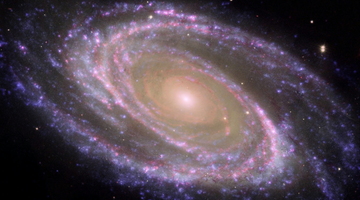Dr Melanie Johnston-Hollitt, from Victoria University of Wellington, describes what black holes are. She also explains the importance to radio astronomers of black holes at the centres of galaxy clusters.
Transcript
DR MELANIE JOHNSTON-HOLLITT
Black Holes are areas where you’ve got yourself a star and the star, if it is over a certain mass limit, it’s possible for it to collapse into a singularity; we call it, which is a Black Hole. Essentially this has then got a gravitational field which is so strong that even light can’t escape. Hence the term ‘black’. So they are evolutionary points to some types of stars.
In the centre of the galaxies that reside in a galaxy cluster you often find super massive black holes. And these are quite important if you are a radio astronomer because what they do is you can have matter in spiralling into the centre of the black hole and this produces jets of electrons which are travelling very, very close to the speed of light and they emit light in the radio regimes, so you get what we call radio jets coming out of these black holes. You get two jets – perpendicular to the centre of the black hole, so you can detect them with a radio telescope. So understanding the exact mechanism of how these radio jets form by this matter in spiralling into the black hole is not yet known and there is a whole heap of radio astronomers and other physicists working on this particular problem.
I am more interested in if they are there and what their jets can tell me about the larger environment than how the black hole itself works. A black hole is a thing where you don’t understand what is happening in the terms of the physics anymore. So you can you know physicists can tell you how a black hole is created, but no one really knows what happens in a black hole so that is why you get all this science fiction, worm holes and so forth - because, theoretically, these things are possible. But you don’t know and how could you know because if you go into a black hole you can’t send light out, so you can’t sent information out either, so there is a lot of scope there for imagination.
You can’t see a black hole directly. The way that we determine whether or not a black hole is at the centre of a galaxy, say, for example, is you can look at the way that the stars move around the black hole. So you can see the luminous stars orbiting around something which you know must have a certain gravitational field and is there, but you can’t necessarily see it. And the other thing you can do is you can look for what is called an accretion disk. Black holes have disks around them where the material falls into the centre of the black hole and that accretion disk is often visible in things like the X-ray because again there is friction and it causes X-rays to be emitted. So, while you can’t see the black hole itself directly, you can actually see the indicators of them.
Acknowledgement(s):
NASA/ESA
NASA/JPL-Caltech
NASA/Marshall Space Flight Center
Greg Taylor, NRAO, NASA/CXC/SAO


